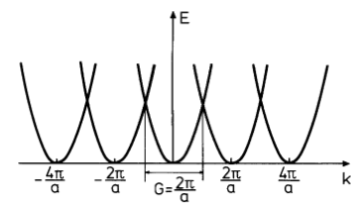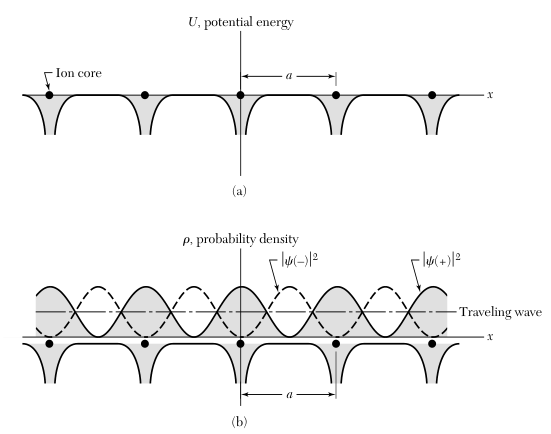Starting from the free electron model (
Zero potential
Even for
but, since
This result has to be considered together with the fact that (due to the periodicity of the reciprocal lattice)
this implies that we have an infinite number of parabolas (

As we can see from the plot above, we can shift everything inside the first BZ to get what is called reduced zone scheme.
Potential different from zero
If
We know that Bragg reflection is a characteristic feature of wave propagation in crystals. Bragg reflection of electron waves in crystals is the cause of energy gaps. […] These energy gaps are of decisive significance in determining whether a solid is an insulator or a conductor. We explain physically the origin of energy gaps in the simple problem of a linear solid of lattice constant a.
Kittel, page 164
1D example
In case of a 1D crystal with spacing
which means
For the first Bragg reflection (
todo WHYYYYYYYYYYYYYY?????????????
The standing waves are labelled
or according to whether or not they change sign when is substituted for . Both standing waves are composed of equal parts of right- and left-directed traveling waves. Kittel, page 165
Electronic density
Ibach Luth, 7.2
The two standing waves
and pile up electrons at different regions, and therefore the two waves have different values of the potential energy in the field of the ions of the lattice. This is the origin of the energy gap. Kittel, page 165
We have, in fact, that the electronic density

As we can see from the plot above,
piles up electrons on lattice sites (i.e. where the ions are), thereby lowering the potential energy in comparison with the average potential energy seen by a traveling wave. , on the other hand, piles up electrons between the ions thereby raising the potential energy in comparison with that seen by a traveling wave. Kittel, page 166
As we can see from the picture above, in the case of a 1D lattice with a weak potential, the energy is similar to the free electron case “far” from the lattice points (where the influence of the ion is weak and thus we are almost in the free electron case). Near the lattice point, on the other hand, the potential of the ions affects more the electrons with low
Quantitative description
Ibach Luth, 7.2
Starting from the Schrödinger equation in k-space:
we want to estimate the coefficients
and a translation by a reciprocal lattice vector
considering
We also make the assumption that only the largest
this is the Von Laue (Bragg) condition, the maximum perturbation occurs at the edge of the first Brillouin zone
For this approximation we only need to consider two relations, one is the Bragg condition, the other is when
Evaluating the coefficients in each condition we have:
- Bragg:
the other terms are negligible, only
the significant coefficient are again only
Supposing
this system has solutions if the determinant of the coefficients is zero
The potential is real, and its Fourier coefficients are:
and if the potential is real
and so
Defining
The determinant is:
at the edge of the first Brillouin zone,
and substituting in the energy relation above:
At the edge the contribution of the two waves with

